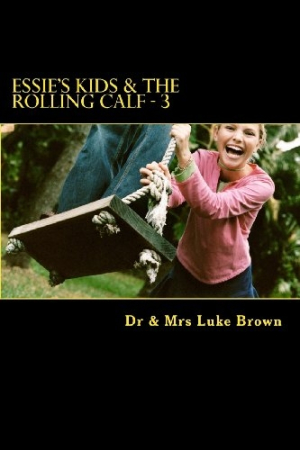Essie's Kids and the Rolling Calf---3
Mystery stories for kids have changed dramatically in the last few decades. Characters like Encyclopedia Brown and The Boxcar Children have been replaced by wizards, vampires, werewolves, and zombies. Innocent sleuthing of creepy houses has been replaced by elaborate battles with powerful supernatural figures. That’s what makes a ghost series like Essie’s Kids & The Rolling Calf stand apart from other children’s series. Husband and wife authors Luke Brown and Berthalicia Fonseca-Brown have created a collection of books that lets kids be … well … kids facing ghostly circumstances.
In this, the third installment, Essie’s children—Gena, Betty, Myrtle, Junior, Leonard, and Karl—are enjoying a wonderful vacation and making friends with neighboring kids in the countryside around Clear Mount, Jamaica. But behind the idyllic background, a ghost roams the land—something called a “rolling calf,” an unnerving, clanking ghost with red eyes. Karl can’t shake the feeling that the rolling calf is after him in particular. After a terrible nightmare, he knows nothing will change until he faces that ghost himself.
Essie’s Kids is refreshing in that it has a spooky premise, but feels more like The Hardy Boys than Harry Potter. Even while Karl knows he must face an unknown and possibly dangerous adversary, he is surrounded by a family that cares for him. This is a world where kids go five miles to the perfect place to swim or girls spend the day jumping rope. When the adventure does get going, the characters never lose the camaraderie of friends, the touchstone of solid parents, or the importance of a lesson learned.
Karl’s world is such a pleasant one that many readers may long to see more. While we read about squeaky floors as Karl walks and girls playing hopscotch on squares drawn in dirt roads, the Browns do not provide enough description of the setting. Essie’s Kids has many opportunities to show us Jamaica from a child’s eyes—the homey bungalow where the family stays, the green and rolling countryside, or the clear, sun-freckled waters of the nearby river. These opportunities to give readers vivid images are longingly missed.
The lack of description may be by design. The text is laid out with no illustrations and includes an area at the back for children to cultivate their imagination by drawing their own images. It’s a nice touch in a book that’s written with a simplicity that will appeal to younger readers, but that has the length to attract older kids.
Nonetheless, in some places, it feels like Essie’s Kids is trying to capture too broad of an audience. For instance, when Karl faces the rolling calf, the authors describe his nervousness as, “His hands shook like a geriatric patient with Parkinson’s disease.” This example might be fine with older readers, but it may leave younger members of the audience grasping for appropriate imagery.
Essie’s Kids is personal and heartfelt, and each book in the series contains a moral. In this installment, Essie tells her kids to be positive in the face of adversity. This kind of message shows that it doesn’t matter if you’re facing down a rolling calf, He-Who-Shall-Not-Be-Named, or a bully in a school yard. Being positive is a universal lesson that can improve the lives of children—and maybe even that of some adults.
Reviewed by
Katerie Prior
Disclosure: This article is not an endorsement, but a review. The publisher of this book provided free copies of the book and paid a small fee to have their book reviewed by a professional reviewer. Foreword Reviews and Clarion Reviews make no guarantee that the publisher will receive a positive review. Foreword Magazine, Inc. is disclosing this in accordance with the Federal Trade Commission’s 16 CFR, Part 255.

